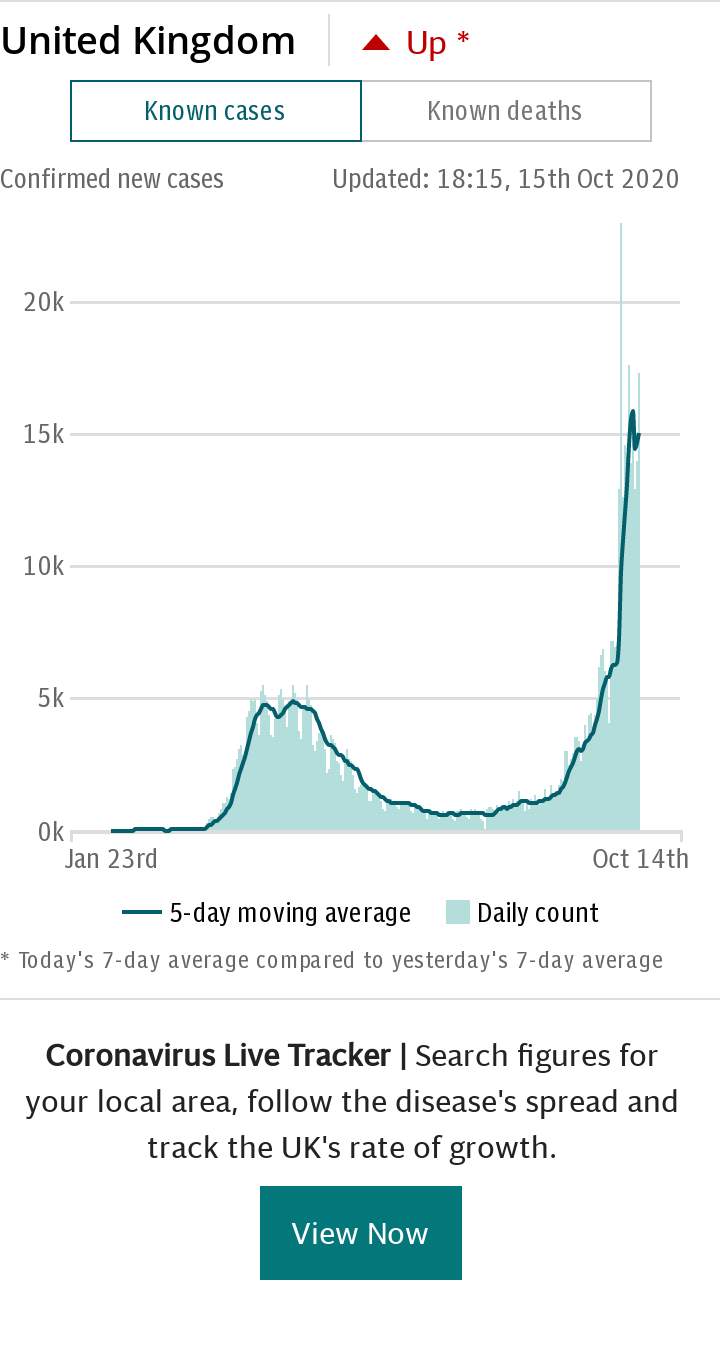Quarter of UK population heads for lockdown as Covid infections rise 60pc in a week


A quarter of the UK population will soon be under lockdown, with London added to the "watch list" after national infections leapt 60 per cent in a week.
More than 17.5 million people will be living under some form of local restrictions by Sunday evening after the rate of infection went up again on Friday.
New measures, applying in England to Leeds, Wigan, Stockport and Blackpool from midnight on Friday, were announced after the Office for National Statistics (ONS) revealed that there were 9,600 new coronavirus infections per day in the week up to September 19, compared to 6,000 the week before (the case rate is shown in the graphic below).

In Wales, Cardiff and Swansea will go into local lockdown from 6pm on Sunday, the Welsh government confirmed.
London is teetering on the brink of further restrictions after being designated as an "area of concern" on Friday. No additional measures will be taken in the city, but testing capacity will be increased to monitor the passage of the outbreak more closely.
London Councils, which represents the city's 32 borough authorities, urged residents to follow the new Government restrictions introduced on Thursday. It said the rising cases were a "stark reminder that now is time for all Londoners to pull together and take action to keep themselves, their families and their communities safe, and to ensure that London's economy is protected".
The official rate of infection, the 'R' value, is now somewhere between 1.2 to 1.5, the Government believes, compared to between 1.1 to 1.4 the previous week.
Officials in Leeds announced an expected ban on households mixing in each others' homes from midnight ahead of confirmation from the Department of Health and Social Care.
The seven-day rolling average of cases in Blackpool has risen from 48.8 per 100,000 a week ago to 69.6 per 100,000 on Friday. Restrictions are already in force across large swathes of North West England, West Yorkshire, the North East and the Midlands, as well as parts of west Scotland.
A ban on households mixing indoors was extended across Northern Ireland earlier this week by Arlene Foster (watch her announcement in the video below).
Dr Konstantin Blyuss, a mathematician at the University of Sussex, said: "The latest data show that the infection is currently growing exponentially in all regions of England, and of the UK as a whole.
"Whereas there are some differences between regions in terms of the proportion of population testing positive, there appears to be very little difference in rates of growth, suggesting that it is no longer possible to consider the situation from the perspective of just individual hotspots driving the overall trend. Rather, all regions are already experiencing growth in cases."
Friday saw the announcement of 6,874 new cases across the UK, with 34 deaths.
Mary Ramsay, the head of immunisation at Public Health England said: "All of the data sources show that the virus is continuing to spread throughout the community, with stubbornly high rates among younger people (infection rates by age group are illustrated in the graphic below). "As students return to university, they must remember to avoid gathering in large groups and stick to the 'rule of six'."
The Mayor of London, Sadiq Khan, pointed to a lack of testing capacity in the capital as the reason why it had become an area of concern, saying: "London is at a very worrying tipping point right now. We're seeing a sharp rise in 111 calls, hospital admissions and patients in ICU.
"The near collapse of test and trace and the resurgence of the virus means new measures to slow its spread were absolutely necessary. Testing capacity was diverted away from London in the last two weeks to other national hotspots and weekly testing numbers are now down 43 per cent in the capital since mid-August."

 Yahoo News
Yahoo News 